Week 34: Practice Executive Functioning Skills with an After School Checklist
Using a visual schedule to prompt a discussion about how to use the time after school is a great way to teach time management, planning, and organization – all things that fall into the executive functioning bucket.
A visual schedule can also be a huge help during those crazy after school hours. As my kids get older, and their homework gets more involved, and their activities multiply, I find that it’s harder to make sure that everything that needs to get done actually gets done every afternoon. And it’s even harder to make sure the responsibility for getting everything done falls on the kids and not on me!
Daily After School Checklist
For some, a simple daily checklist may do the trick.
When my kids were younger, this list was a great way to put them in charge of their own after school schedule and help them make the necessary decisions about how to spend their afternoon. Here is how the visual list helped them, and the skills they practiced:
Planning Skills
- Have your kids help you make their list. They will feel more ownership this way, and they will learn the important skill of enumerating all the tasks. This will also make it very clear what your expectations are.
Task initiation
- Once you have the list, leave it up to your kids to work through it. They may need help, but make sure the tone you set is that you are helping them get their jobs done, rather than them helping you get your job done!
Time Estimates
- One thing your kids may need help with is time estimates so they can plan their after school hours. Get in the practice of talking together after school each day about the items on their list. In particular, it’s helpful to talk through whether they have a lot of homework, or a little homework, and then make a plan for when and how it will all get done. If there are other variable tasks on the list (like a daily chore that changes each day) talk that over too. Practicing these time estimates will serve them really will as their homework gets more complicated.
Monitoring Progress
- The printed schedule makes it really easy to visualize whether or not good progress is being made. If school has been out for 2 hours, and only 2 of the 6 tasks on the list are completed, that’s a good indication that something needs to change! You can put the list in a plastic protector and use it with a dry erase marker so that you can keep using the list over and over.
Weekly After School Chart
Older kids may need to be able to plan for a week at a time, especially as their homework and activities get more involved, or you expect them to do more of their own time management
Longer-term Planning/Prioritization
- Older kids may be doing more advanced time estimates, like figuring out that they are extra busy on Tuesdays and Thursdays with soccer practice, so the bulk of the homework needs to happen on Mondays and Wednesdays. Or they may need to be scheduling longer-term projects, or figuring out how to fit in enough practice sessions for a musical instrument over the course of a week. The visual schedule helps make this clearer.
Chores
- I find this weekly planner also allows me to do things like more easily split up the chores between the kids. My kids trade off nights for setting the table, and with this weekly list we avoid fights about whose turn it is.
Flexibility
- Some people worry that a checklist will be too rigid, but in reality it can help your kids be more flexible. If a last minute invitation comes along, it’s much easier to evaluate whether or not there’s time to fit it in if you have a good idea of what else needs to be done that day!
There are lots of skills that have to be learned in order to be good at executive functioning, and practicing them daily can go a long way towards helping to tackle this complicated goal!





